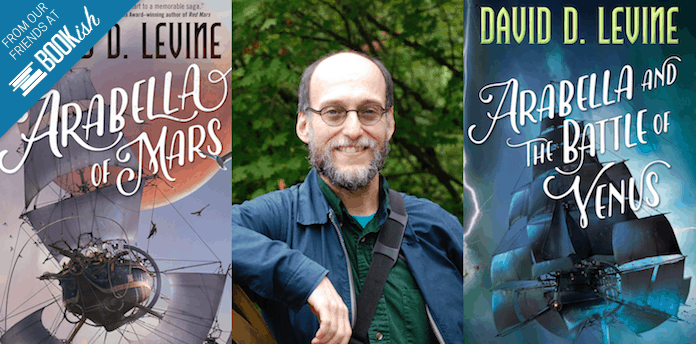by David D. Levine
BookTrib is partnering with Bookish to bring you more great content, including this article by David D. Levine, author of The Adventures of Arabella Ashby novels, and the most recent, Arabella and the Battle Venus.
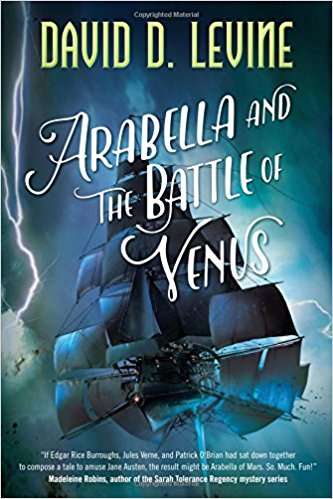 Sure, ships are cool. But you know what’s even cooler? Flying ships. David D. Levine, author of Arabella and the Battle of Venus, knows this better than most as his work features several of these majestic vessels. Here, he shares his favorite flying ships with Bookish readers.
Sure, ships are cool. But you know what’s even cooler? Flying ships. David D. Levine, author of Arabella and the Battle of Venus, knows this better than most as his work features several of these majestic vessels. Here, he shares his favorite flying ships with Bookish readers.
I am certainly not alone in my love of flying sailing ships—by which I mean wooden ships with sails, keels, yardarms, and cannons which somehow, in defiance of all our universe’s laws of physics, fly through the air or ply the aether between planets—and images of this type of ship are a remarkably common trope in science fiction convention art shows, DeviantArt, video games, anime, and movies. But, surprisingly, they are not all that common in literature, and many of those that do appear are technically dirigibles. Nevertheless, here is a list of some of my favorites; many of these provided inspiration for the Diana in my own Arabella of Mars and Touchstone in sequel Arabella and the Battle of Venus.
Leviathan
 More recently published, the eponymous Leviathan in Leviathan by Scott Westerfeld is an enormous living dirigible, a lighter-than-air warbeast created from whale stock by genetic engineering and handwavium. This book, the first in a trilogy, takes place in an alternate universe on the brink of World War I, in which the Clankers of the Austro-Hungarian Empire have armed themselves with gigantic walking war machines while the Darwinists of England employ a technology based upon the manipulation of animals’ “life threads,” and is delightfully illustrated by Keith Thompson.
More recently published, the eponymous Leviathan in Leviathan by Scott Westerfeld is an enormous living dirigible, a lighter-than-air warbeast created from whale stock by genetic engineering and handwavium. This book, the first in a trilogy, takes place in an alternate universe on the brink of World War I, in which the Clankers of the Austro-Hungarian Empire have armed themselves with gigantic walking war machines while the Darwinists of England employ a technology based upon the manipulation of animals’ “life threads,” and is delightfully illustrated by Keith Thompson.
Sophronia
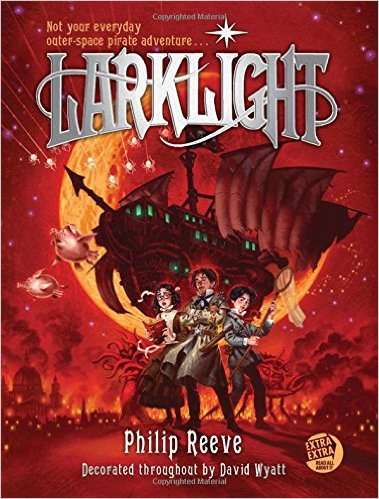 The aether-ship Sophronia in Larklight by Philip Reeve is a pirate vessel, a rough and disreputable ship captained by the mysterious Jack Havock and crewed by a motley assortment of aliens. Larklight is a lark indeed, a Victorian confection full of strange worlds, giant mechanical spiders, and hairsbreadth escapes, and the Sophronia is powered by “alchemical engines” which do whatever is needed by the plot. Nevertheless, it all hangs together and is remarkably entertaining.
The aether-ship Sophronia in Larklight by Philip Reeve is a pirate vessel, a rough and disreputable ship captained by the mysterious Jack Havock and crewed by a motley assortment of aliens. Larklight is a lark indeed, a Victorian confection full of strange worlds, giant mechanical spiders, and hairsbreadth escapes, and the Sophronia is powered by “alchemical engines” which do whatever is needed by the plot. Nevertheless, it all hangs together and is remarkably entertaining.
Tzadkiel’s Ship
 The unnamed ship of Tzadkiel in The Urth of the New Sun by Gene Wolfe is a spaceship which is made of wood and has “masts beyond counting;” each mast “bends ever so slightly, bowing to the wind from the suns” and “carries a thousand spars, and every spar spreads a sail of fuligin and silver.” This ship sails through an interplanetary space lacking both gravity and air—the passengers and crew are provided with “cloaks of air” for their survival, but “the void hushes every voice… I have heard it said that if it were not thus, the roaring of the suns would deafen the universe.” This last sentence, which I read when Urth of the New Sun was first published in 1987, actually planted the seed which eventually grew into Arabella’s world. What would the universe be like, I asked myself, if the sky were full of air?
The unnamed ship of Tzadkiel in The Urth of the New Sun by Gene Wolfe is a spaceship which is made of wood and has “masts beyond counting;” each mast “bends ever so slightly, bowing to the wind from the suns” and “carries a thousand spars, and every spar spreads a sail of fuligin and silver.” This ship sails through an interplanetary space lacking both gravity and air—the passengers and crew are provided with “cloaks of air” for their survival, but “the void hushes every voice… I have heard it said that if it were not thus, the roaring of the suns would deafen the universe.” This last sentence, which I read when Urth of the New Sun was first published in 1987, actually planted the seed which eventually grew into Arabella’s world. What would the universe be like, I asked myself, if the sky were full of air?
Mistral
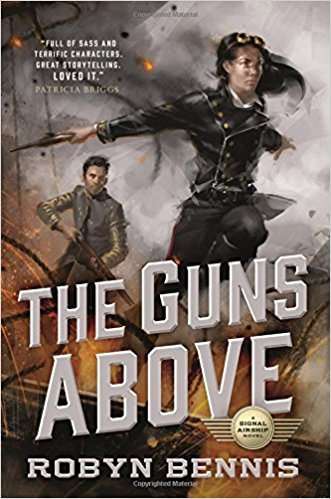 The airship Mistral in The Guns Above by Robyn Bennis is a much more serious ship in a much more serious world—an alternate 19th century at war. Mistral is a bit of a problem child, a prototype dirigible propelled by steam turbine, and is not quite ready for combat, especially given that her captain, Josette Dupre, is the first female airship captain and she’s been saddled with a foppish spy to make sure she fails. But despite considerable stress and quite a bit of blood and guts, Mistral and her captain win out, and the book is full of wit and considerable charm.
The airship Mistral in The Guns Above by Robyn Bennis is a much more serious ship in a much more serious world—an alternate 19th century at war. Mistral is a bit of a problem child, a prototype dirigible propelled by steam turbine, and is not quite ready for combat, especially given that her captain, Josette Dupre, is the first female airship captain and she’s been saddled with a foppish spy to make sure she fails. But despite considerable stress and quite a bit of blood and guts, Mistral and her captain win out, and the book is full of wit and considerable charm.
Kipling’s mail-carrying fleet
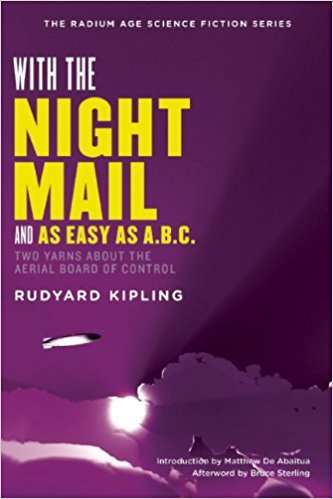 Going further back in time, Rudyard Kipling’s With the Night Mail is an adventure story featuring a fleet of mail-carrying airships lifted by a mysterious and physics-defying “Fleury’s Gas” energized by “Fleury’s Ray.” (Yes, the very same Rudyard Kipling who wrote The Jungle Book also wrote science fiction!) The truly remarkable thing about this story is that, in its initial publication, it appeared together with illustrations and advertisements from the world in which the story takes place. In effect, the whole thing is an artifact from another world, a metafictional conceit which is a particular favorite of mine.
Going further back in time, Rudyard Kipling’s With the Night Mail is an adventure story featuring a fleet of mail-carrying airships lifted by a mysterious and physics-defying “Fleury’s Gas” energized by “Fleury’s Ray.” (Yes, the very same Rudyard Kipling who wrote The Jungle Book also wrote science fiction!) The truly remarkable thing about this story is that, in its initial publication, it appeared together with illustrations and advertisements from the world in which the story takes place. In effect, the whole thing is an artifact from another world, a metafictional conceit which is a particular favorite of mine.
Surprise
 And, finally, even though she never flies, I cannot conclude this list of beloved ships without including the dear Surprise from Patrick O’Brian’s Aubrey/Maturin books, historical fiction with no fantastic element (unless you count Captain Aubrey’s amazing ability to be in the most exciting place at the right time, which requires the Napoleonic wars to run for several additional years beyond their actual time). This ship, although she does not appear until the third novel in the series (fittingly titled H.M.S. Surprise), is the most closely associated with the series and is the most beloved of all Jack Aubrey’s commands. A small ship of outdated design—a mere sixth-rate frigate with only 28 guns—she is nonetheless fast, handsome, and a very smooth sailer in the right hands. My Diana, although she replies upon improbable and contrafactual physics, owes more to Surprise than any other ship in this list, and I would be enormously pleased if she eventually became even one-tenth as well loved as her predecessor.
And, finally, even though she never flies, I cannot conclude this list of beloved ships without including the dear Surprise from Patrick O’Brian’s Aubrey/Maturin books, historical fiction with no fantastic element (unless you count Captain Aubrey’s amazing ability to be in the most exciting place at the right time, which requires the Napoleonic wars to run for several additional years beyond their actual time). This ship, although she does not appear until the third novel in the series (fittingly titled H.M.S. Surprise), is the most closely associated with the series and is the most beloved of all Jack Aubrey’s commands. A small ship of outdated design—a mere sixth-rate frigate with only 28 guns—she is nonetheless fast, handsome, and a very smooth sailer in the right hands. My Diana, although she replies upon improbable and contrafactual physics, owes more to Surprise than any other ship in this list, and I would be enormously pleased if she eventually became even one-tenth as well loved as her predecessor.

